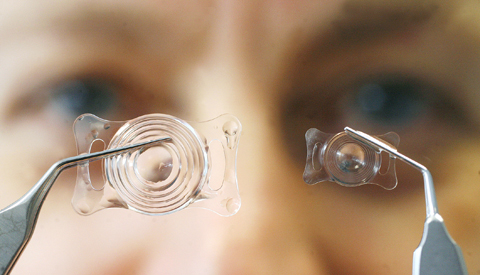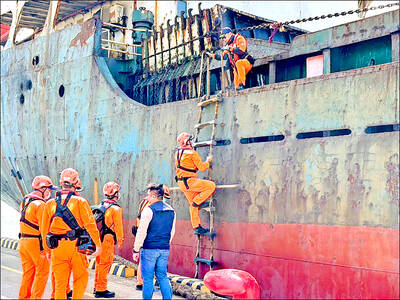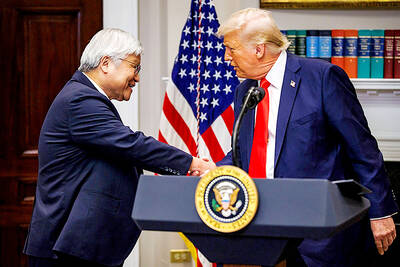Lions, giraffes, tigers, rabbits, bears, rhinoceroses and even owls can go blind from cataracts, but an east German firm has an answer: custom-made “contact lenses.”
The procedure is delicate, to say the least, and requires special training for veterinarians. But it has propelled tiny S&V Technologies, founded by Bavarian chemist and entrepreneur Christine Kreiner in the former communist east, to global leadership in a highly specialized field.
The acrylic intraocular lenses are implanted into animals’ eyes when their vision has clouded to the point of total impairment and are fitted for various species — from cat-eye-sized to fist-width for rhinos.

PHOTO: AFP
“Cataracts generally means blindness for animals, unlike for humans,” said the head of the company’s veterinary division, Ingeborg Fromberg.
“And because animals have short life spans, it means losing quality of life in a greater share of that life,” Fromberg said.
Since its launch last year, the company has fielded calls from Sea World in San Diego (a sea lion that had trouble performing tricks because of severely blurry vision), an Australian nature park (a blind kangaroo) and a Romanian zoo (a visually impaired lioness).
The German lenses have helped turn the lights back on for dozens of house pets, racehorses, circus animals, guide dogs — literally preventing the blind leading the blind — and even wild creatures roaming nature reserves.
Special lenses that absorb UV rays can also be used to help horses afflicted with “head shaker syndrome,” an excruciating and ultimately life-threatening ailment.
Although the expense of such an operation and subsequent check-ups can run into the thousands of dollars, the procedure is often worth it for animals that have gone blind — and for their owners.
“When something is unsettling for an animal, when they don’t have a good sense of their surroundings, they can begin to get aggressive or unpredictable or withdrawn,” Fromberg said.
That can mean the pricey investment in training an animal is wasted.
Impaired vision can also blunt the sex drive, stopping animals from reproducing. The World Wildlife Fund, for example, has paid for lens transplants for brown bears in a preserve in China.
“Of course that is only one side of it — some are pets and seen as members of the family and worth any expense,” Fromberg said.
She said the trickiest part of treating big animals such as elephants and rhinos is the anesthesia.
“If larger animals lie for too long on one side during an operation, then it puts too much pressure on the heart. That makes things a bit harder,” she said.
“With a giraffe, for example, its head may never be lower than its heart. Every animal has its peculiarities that you have to contend with,” she said.
Chief executive Kreiner, a 64-year-old from Munich, chose to set up her unusual firm in Hennigsdorf, a sleepy riverside town that has become a high-tech haven in the 20 years since the Berlin Wall fell.
On the capital’s northern outskirts, Henningsdorf also made smart business sense because the EU and the German government both pitched in to provide one-third of the startup costs.
Kreimer has founded five different firms in her years in business and said she was drawn to Germany’s ex-communist east in the heady trailblazing mood of national unification in 1990.
“I thought at the time that it would be better to go to a poorer part of Germany rather than stay in Bavaria,” the prosperous southern state, she said.
“The thinking was that it would be less bureaucratic in an eastern state, and that the subsidies would be better than in the west. It was the right decision,” she said.
Her various enterprises blossomed and evolved over the years, culminating in the founding of S&V Technologies in January last year. The company now even has a US subsidiary in Salt Lake City.
S&V posted turnover of nearly 2.5 million euros (US$3.5 million) last year. Kreiner expects it to grow by one-third this year based on lens sales, as well as a thriving anti-wrinkle products division — for humans.
She employs 32 people with another five to join this year.
“There are no global players active in this area that are able to crush medium-sized firms with a major marketing operation,” Kreiner said, adding that her few competitors — in Canada, France and the US — are all smaller than S&V.
The main limit to her business’s growth is a lack of vets able to perform the implantation procedure, which is why she now organizes training weekends for animal doctors from around the globe.
Participants have come from as far as Australia, Brazil, Japan, Taiwan and the United States to learn the procedure in the company laboratory on eyes harvested from animal cadavers.

A Chinese freighter that allegedly snapped an undersea cable linking Taiwan proper to Penghu County is suspected of being owned by a Chinese state-run company and had docked at the ports of Kaohsiung and Keelung for three months using different names. On Tuesday last week, the Togo-flagged freighter Hong Tai 58 (宏泰58號) and its Chinese crew were detained after the Taipei-Penghu No. 3 submarine cable was severed. When the Coast Guard Administration (CGA) first attempted to detain the ship on grounds of possible sabotage, its crew said the ship’s name was Hong Tai 168, although the Automatic Identification System (AIS)

An Akizuki-class destroyer last month made the first-ever solo transit of a Japan Maritime Self-Defense Force ship through the Taiwan Strait, Japanese government officials with knowledge of the matter said yesterday. The JS Akizuki carried out a north-to-south transit through the Taiwan Strait on Feb. 5 as it sailed to the South China Sea to participate in a joint exercise with US, Australian and Philippine forces that day. The Japanese destroyer JS Sazanami in September last year made the Japan Maritime Self-Defense Force’s first-ever transit through the Taiwan Strait, but it was joined by vessels from New Zealand and Australia,

SECURITY: The purpose for giving Hong Kong and Macau residents more lenient paths to permanent residency no longer applies due to China’s policies, a source said The government is considering removing an optional path to citizenship for residents from Hong Kong and Macau, and lengthening the terms for permanent residence eligibility, a source said yesterday. In a bid to prevent the Chinese Communist Party (CCP) from infiltrating Taiwan through immigration from Hong Kong and Macau, the government could amend immigration laws for residents of the territories who currently receive preferential treatment, an official familiar with the matter speaking on condition of anonymity said. The move was part of “national security-related legislative reform,” they added. Under the amendments, arrivals from the Chinese territories would have to reside in Taiwan for

CRITICAL MOVE: TSMC’s plan to invest another US$100 billion in US chipmaking would boost Taiwan’s competitive edge in the global market, the premier said The government would ensure that the most advanced chipmaking technology stays in Taiwan while assisting Taiwan Semiconductor Manufacturing Co (TSMC, 台積電) in investing overseas, the Presidential Office said yesterday. The statement follows a joint announcement by the world’s largest contract chipmaker and US President Donald Trump on Monday that TSMC would invest an additional US$100 billion over the next four years to expand its semiconductor manufacturing operations in the US, which would include construction of three new chip fabrication plants, two advanced packaging facilities, and a research and development center. The government knew about the deal in advance and would assist, Presidential